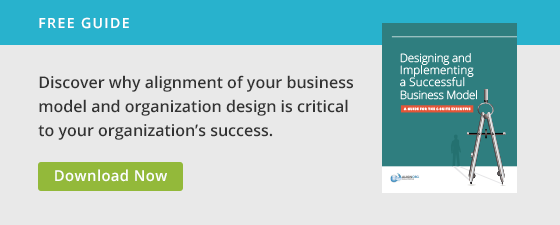Strategic thinking is essential for an organization to differentiate and ultimately win in the marketplace. However, strategic thinking is much more than the ability to apply data, trends, and themes or envision big ideas. While these skills are certainly important for leaders of an organization, they don’t ensure that these ideas, trends, and themes end up in the organization’s design. I see one of the missing elements of strategic thinking as the ability of leaders to foresee the implications or consequences of their strategies in the choices their organizations must make.
When we shift our understanding of strategic thinking to understanding the consequences of implementing a strategy, strategic thinking becomes much more applicable and beneficial to an organization. For example, in a planning session I facilitated, one participant constantly offered new, fresh, and extremely innovative ideas about possible directions for the company strategy. Unfortunately, his contributions were all but useless during the session since he could not foresee how his ideas would ultimately affect the resources, talent, and organization choices for his company. Because the implications of his ideas couldn’t be envisioned, the leadership team stalled when he was advocating for his ideas and they ultimately shifted their thinking to strategic ideas for which they could see and anticipate the organizational implications.
This situation is not uncommon, and even though a team might be off the charts in innovation, the inability to see the consequences of choices most often proves the limiting factor in strategic planning efforts.
So, what can you do to foster and develop practical, strategic thinking amongst your leadership team?
Create Forums. Forums are a great way to allow leaders to think and talk through the implications of a corporate strategy. This is not just leadership development, but live opportunities to leverage strategic thinking to spot organizational misalignments and better align your business processes to your strategy.
Make time for strategic discussions in meetings. When executives model practical strategic thinking and consciously take time for it in meetings, they set a precedent for the entire organization and provide an environment to learn and practice the skill of connecting strategy to organization choices. This may take the form of making trade-offs or discussing the implications of a choice (past or present).
Cascade strategic thinking throughout the organization. Having strategic discussions at the executive level is great, but if the conversations stay there then the organization will not be affected by the discussion.
One of our clients took this suggestion very seriously and developed a robust strategic planning and deployment process. Not only does the process ensure that the right strategic conversations happen on a regular basis, but that those discussions cascade through the organization in tangible ways. In this organization’s case, their strategic planning process forced leaders throughout the organization to talk about the implications of strategic direction and how that would affect other priorities, resource allocation, organization structure, skills and talent needs, and other organization capabilities.
Have proper frameworks and tools. When you provide the right tools and frameworks, leaders can see and process strategic information and organization choice options in tangible ways. We often use a Rubik’s Cube as a visual representation of the different aspects of an organization that leaders must consider when setting strategy and then making organizational choices. Just like a Rubik’s Cube, no choice happens in isolation but instead affects every other aspect of the organization.
Similar frameworks prove helpful in understanding and teaching leaders how to foresee the organizational consequences of their strategic planning options.
We often receive comments from senior leaders about the richness of our planning and design session discussions because we help leaders play out scenarios, debate strategic and organizational options, see tangible implications, and think through the work, structure, information, metrics, people, and culture choices needed to enable strategy. Like anyone else, we appreciate a good compliment, but our facilitation success stems largely around the suggestions above—committing time to strategic thinking, planning for it in our sessions, utilizing useful tools, and ensuring that discussions move from big ideas to practical implications for strategic choices.
Editor’s note: This blog was originally published on Feb. 8, 2017 and has since been updated with new content.

